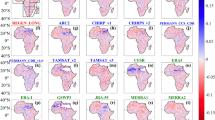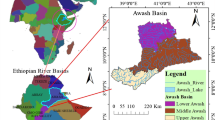Abstract
This paper evaluates the predictability and skill of the models from the North American Multi-Model Ensemble project (NMME) in South America on seasonal timescales using analysis of variance (ANOVA). The results show that the temperature variance is dominated by the multi-model ensemble signal in the austral autumn and summer and by the inter-model biases in the austral spring and winter. The temperature predictability is higher at low latitudes, although moderate values are found in extratropical latitudes in the austral spring and summer. The predictability of precipitation is lower than that of temperature because noise dominates the variance. The highest levels of precipitation predictability are reached in tropical latitudes with large inter-seasonal variations. Southeastern South America and Patagonia present the highest predictability at midlatitudes. The NMME skill of temperature is better than that of precipitation, and it is better at low latitudes for both variables. At extratropical latitudes, the skill is moderate for temperature and low for precipitation, although precipitation reaches a local maximum in southeastern South America.











Similar content being viewed by others
Data availability
Raw data can be found at http://iridl.ldeo.columbia.edu/SOURCES/.Models/.NMME/. Data supporting the findings of this article is available upon request.
References
Barreiro M (2010) Influence of ENSO and the south Atlantic ocean on climate predictability over southeastern South America. Clim Dyn 35:1493–1508
Barreiro M, Chang P, Saravanan R (2002) Variability of the south Atlantic convergence zone simulated by an atmospheric general circulation model. J Clim 15(7):745–763
Becker E, van den Dool H, Zhang Q (2014) Predictability and forecast skill in nmme. J Clim 27(15):5891–5906
Becker E, Kirtman B, Pegion K (2020) Evolution of the north American multi-model ensemble (nmme). Geophys Res Lett 47
Bombardi RJ, Trenary L, Pegion K, Cash B, DelSole T, Kinter JL (2018) Seasonal predictability of summer rainfall over south America. J Clim 31(20):8181–8195
Cai W, McPhaden M, Grimm A, Rodrigues R, Taschetto A, Garreaud R, Dewitte B, Poveda G, Ham Y-G, Santoso A, Ng B, Anderson W, Wang G, Geng T, Jo H-S, Marengo J, Alves L, Osman M, Li S, Vera C (2020) Climate impacts of the el niño-southern oscillation on south America. Nat Rev Earth Environ 1:215–231
Campitelli E (2021) metR: tools for easier analysis of meteorological fields. R package version 0.10.0
Cash B, Burls N (2019) Predictable and unpredictable aspects of us west coast rainfall and el niño: understanding the 2015–2016 event. J Clim 32(10):2843–2868
Cash B, Manganello J, Kinter J (2019) Evaluation of nmme temperature and precipitation bias and forecast skill for south Asia. Clim Dyn 53:7363–7380
Coelho CAS, Stephenson DB, Doblas-Reyes FJ, Balmaseda M (2006) The skill of empirical and combined/calibrated coupled multi-model south American seasonal predictions during ENSO. Adv Geosci 6:51–55
Fan Y, van den Dool H (2008) A global monthly land surface air temperature analysis for 1948–present. J Geophys Res. https://doi.org/10.1029/2007JD008470
Gubler S, Sedlmeier K, Bhend J, Avalos G, Coelho CAS, Escajadillo Y, Jacques-Coper M, Martinez R, Schwierz C, de Skansi M, Spirig C (2020) Assessment of ecmwf seas5 seasonal forecast performance over south America. Weather Forecast 35(2):561–584
Hodson D, Sutton R (2008) Exploring multi-model atmospheric gcm ensembles with ANOVA. Clim Dyn 31:973–986
Kirtman BP, Min D, Infanti JM, Kinter James LI, Paolino DA, Zhang Q, van den Dool H, Saha S, Mendez MP, Becker E, Peng P, Tripp P, Huang J, DeWitt DG, Tippett MK, Barnston AG, Li S, Rosati A, Schubert SD, Rienecker M, Suarez M, Li ZE, Marshak J, Lim Y-K, Tribbia J, Pegion K, Merryfield WJ, Denis B, Wood EF (2014) The north American multimodel ensemble: phase-1 seasonal-to-interannual prediction; phase-2 toward developing intraseasonal prediction. Bull Am Meteorol Soc 95(4):585–601
Kumar A, Peng P, Chen M (2014) Is there a relationship between potential and actual skill? Mon Weather Rev 142:2220–2227
Lin H, Merryfield W, Muncaster R, Smith G, Markovic M, Dupont F, Roy F, Lemieux J.-F, Dirkson A, Kharin V, Lee W-S, Charron M, Erfani A (2020) The Canadian seasonal to interannual prediction system version 2 (cansipsv2). Weather Forecast. https://doi.org/10.1175/WAF-D-19-0259.1
Nobre P, Marengo JA, Cavalcanti IFA, Obregon G, Barros V, Camilloni I, Campos N, Ferreira AG (2006) Seasonal-to-decadal predictability and prediction of south American climate. J Clim 19(23):5988–6004
Nychka D, Furrer R, Paige J, Sain S (2017) fields: tools for spatial data. R package version 12:3
Osman M, Vera C (2017) Climate predictability and prediction skill on seasonal time scales over south America from chfp models. Clim Dyn 49:2365–2383
Osman M, Vera CS (2020) Predictability of extratropical upper-tropospheric circulation in the southern hemisphere by its main modes of variability. J Clim 33(4):1405–1421
Osman M, Coelho CAS, Vera CS (2021) Calibration and combination of seasonal precipitation forecasts over South America using Ensemble Regression. Clim Dyn 57:2889–2904
Peng P, Kumar A, Wang W (2009) An analysis of seasonal predictability in coupled model forecasts. Clim Dyn 36:637–648
R Core Team (2020) R: a language and environment for statistical computing. R Foundation for Statistical Computing, Vienna, Austria
Reynolds R, Smith T, Liu C, Chelton D, Casey K (2007) Daily high-resolution-blended analyses for sea surface temperature. J Clim 20(22):5473–5496
Rodrigues LRL, Doblas-Reyes FJ, Coelho CAS (2019) Calibration and combination of monthly near-surface temperature and precipitation predictions over Europe. Clim Dyn 53(12):7305–7320
Ronchail J, Cochonneau G, Molinier M, Guyot J-L, De Miranda Chaves AG, Guimarães V, de Oliveira E (2002) Interannual rainfall variability in the amazon basin and sea-surface temperatures in the equatorial pacific and the tropical atlantic oceans. Int J Climatol 22(13):1663–1686
Slater LJ, Villarini G, Bradley AA (2019) Evaluation of the skill of north-American multi-model ensemble (nmme) global climate models in predicting average and extreme precipitation and temperature over the continental USA. Clim Dyn 53(12):7381–7396
Storch HV, Zwiers FW (1999) Analysis of variance. Statistical analysis in climate research. Cambridge University Press, Cambridge, pp 171–192
Taschetto A, Wainer I (2008) Reproducibility of south American precipitation due to subtropical south Atlantic ssts. J Clim 21:2835–2851
Tompkins AM, Zárate MIOD, Saurral RI, Vera C, Saulo C, Merryfield WJ, Sigmond M, Lee W-S, Baehr J, Braun A, Butler A, Déqué M, Doblas-Reyes FJ, Gordon M, Scaife AA, Imada Y, Ishii M, Ose T, Kirtman B, Kumar A, Müller WA, Pirani A, Stockdale T, Rixen M, Yasuda T (2017) The climate-system historical forecast project: Providing open access to seasonal forecast ensembles from centers around the globe. Bull Am Meteorol Soc 98(11):2293–2301
Towner J, Cloke HL, Lavado W, Santini W, Bazo J, Coughlan de Perez E, Stephens EM (2020) Attribution of amazon floods to modes of climate variability: A review. Meteorol Appl 27(5):e1949
Wilks DS (1995) Statistical methods in the atmospheric sciences. Academic Press, San Diego
Wu R, Kirtman B (2006) Changes in spread and predictability associated with ENSO in an ensemble coupled GCM. J Clim 19(17):4378–4396
Xie P, Arkin PA (1997) Global precipitation: a 17-year monthly analysis based on gauge observations, satellite estimates, and numerical model outputs. Bull Am Meteorol Soc 78(11):2539–2558
Yoon J-H, Zeng N (2009) An Atlantic influence on amazon rainfall. Clim Dyn 34:249–264
Zhao T, Zhang Y, Chen X (2019) Predictive performance of nmme seasonal forecasts of global precipitation: a spatial-temporal perspective. J Hydrol 570:17–25
Zwiers F (1996) Interannual variability and predictability in an ensemble of amip climate simulations conducted with the ccc gcm2. Clim Dyn 12:825–847
Zwiers FW, Wang XL, Sheng J (2000) Effects of specifying bottom boundary conditions in an ensemble of atmospheric gcm simulations. J Geophys Res Atmos 105(D6):7295–7315
Acknowledgements
We thank the two anonymous reviewers for their comments. We acknowledge the agencies that support the NMME-Phase II system, and we thank the climate modeling groups (Environment Canada, NASA, NCAR, NOAA/GFDL, NOAA/NCEP, and University of Miami) for producing and making available their model output. NOAA/NCEP, NOAA/CTB, and NOAA/CPO jointly provided coordinating support and led development of the NMME-Phase II system.
Funding
The research was supported by UBACyT20020170100428BA, PDE 46 2019, PICT-2018-03046, CLIMAT-AMSUD 21-CLIMAT-05 and the CLIMAX Project funded by Belmont Forum/ANR-15-JCL/-0002-01. LGA is supported by a fellowship grant from CONICET.
Author information
Authors and Affiliations
Contributions
LGA: data curation; formal analysis; investigation; methodology; visualization; writing—original draft; writing—review and editing. MO: conceptualization; data curation; supervision; methodology; writing—review and editing. CSV: conceptualization; funding acquisition; methodology; project administration; resources; supervision; writing—review and editing.
Corresponding author
Ethics declarations
Conflict of interest
The authors declare that they have no conflict of interests that could have influenced the work reported in this paper.
Ethics approval
Not applicable.
Code availability
All codes used in this work can be found at https://github.com/LucianoAndrian/tesis
Additional information
Publisher's Note
Springer Nature remains neutral with regard to jurisdictional claims in published maps and institutional affiliations.
Rights and permissions
Springer Nature or its licensor holds exclusive rights to this article under a publishing agreement with the author(s) or other rightsholder(s); author self-archiving of the accepted manuscript version of this article is solely governed by the terms of such publishing agreement and applicable law.
About this article
Cite this article
Andrian, L.G., Osman, M. & Vera, C.S. Climate predictability on seasonal timescales over South America from the NMME models. Clim Dyn 60, 3261–3276 (2023). https://doi.org/10.1007/s00382-022-06506-8
Received:
Accepted:
Published:
Issue Date:
DOI: https://doi.org/10.1007/s00382-022-06506-8




